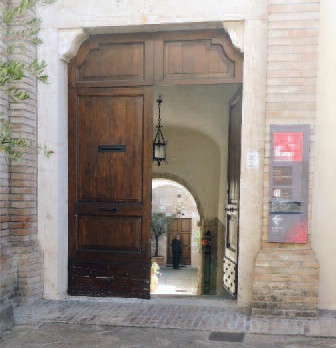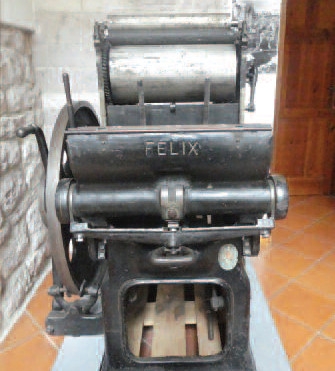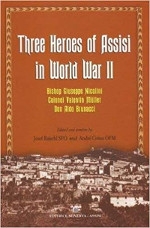Italian Jews Who Trusted a Saint
Story and photos by Laurence Lebor
In the last issue of the ESRAmagazine, I told the story of my bike ride from Florence to Assisi last September, to honor the memory of Gino Bartali. Bartali was the legendary Italian cyclist who saved many Jews in 1943 by hiding false passports and documents in the frame of his bike and distributing them to Jewish refugees, to enable them to escape the clutches of the Nazis.
But there is also another connected story involving the Catholic Church and the residents of Assisi who saved many Jews in 1943 and 1944, which I thought was worth telling separately.
We arrived in Assisi on Sunday evening; we stayed the night in the town and most of the party left early in the morning by coach back to Florence and Rome. My flight home to Israel wasn't until the evening, so I decided to stay in Assisi and explore the town. Asissi is a beautiful small medieval town, with low buildings, narrow streets and porticos. It is home to many ancient churches, and of course the famous Basilica of St Francis.
It was a quiet Monday morning and I walked around the town and found the Museum of Memorial, which honors the role of the Catholic Church in Assisi in protecting and harboring Jews in WW2. The story is that many Jewish refugees fleeing south from the Nazis gravitated towards Assisi because they heard of the tradition that St Francis helped people in distress, so they believed that the people of Asissi would honor that tradition. They were correct in that assumption, and in fact Pope Pius wrote to Bishop Nicolini of Assisi telling him to come to the aid of the Jews and to hide as many of them as possible. This was a surprise to me, having always understood that the Pope was on the side of the Nazis.
Don Aldo Brunacci was Bishop Nicolini's prime collaborator and secretary of the Committee for Assistance to Refugees during WW2. This is part of his testimony* which was typical of the many stories of the Assisi resistance:
"Our first thought was to get the Jewish refugees safely sheltered in the various convents. Our main center was the convent of San Quirico where the Jews were generally housed until we could provide them with ration cards and all the papers they needed to live unmolested. We helped a Polish family who had escaped from a French concentration camp; we helped a Belgian Jewish family named Fintzi - mother, father, and baby girl who was born in Assisi - they were housed in the convent. The couple arrived in Assisi before September 1943, so they registered in their own names. After the German occupation of the town the police came to get them. The Abbess called the Bishop and got permission for the whole family to enter the cloister, a place so sacred that even the Germans did not dare to violate it."
The Jews were free to pray in the quiet convents of Assisi and on October 8, 1943, they celebrated Yom Kippur in the San Quirico monastery. In fact the nuns prepared their after-fast meal and sat down to eat with them.
The Bishop's plan was to hide Jewish refugees whilst new identity cards were provided - either by the cyclist Bartali, or by a small trusted group of collaborators operating under the noses of the Germans in Assisi. A printing press in a souvenir shop owned by a lay Catholic typographer was used at night. The press can still be seen at the museum.
Personal effects, including family mementos and objects or texts used for Jewish religious services (some rabbis were amongst the protected), were hidden behind plaster walls in underground cellars in Bishop Nicolini's residence. Don Aldo described how he and Bishop Nicolini took turns pulling out hidden materials or plastering up walls.
"The work was not done by workers, but by the Bishop himself, who used the trowel to build the walls whilst I held the lantern," he said. "When a wall had to be broken into to retrieve items, I would wield the pick while the Bishop held the light for me."
According to Don Aldo, it was too dangerous to keep precise records of the Jewish population of Assisi, so nothing was written down, but he estimated that about 300 Jews were saved. And in terms of using Church resources to hide and protect Jews, he claimed that practically all the Italian clergy were working on similar lines to them, under the instructions of the Pope.
Also hard to believe, they were assisted in their efforts by a German officer. Colonel Valentin Muller was a medical doctor who was the commander of Assisi. He managed to have Assisi declared a hospital city, mainly for wounded German soldiers. He was a devout Catholic, which made him a natural fit for his role of supervising medical care, rather than military confrontations. Obviously, Muller was never informed or made an accomplice of the rescue of the Jews - it would have made him a traitor and would have certainly compromised the whole operation. But it would be naive to think that he didn't know what was going on. Certainly his repeated interventions against the SS and Gestapo, who were convinced that the convents and nunneries were hiding British and American soldiers, were clearly in favor of the oppressed.
In 1977, Yad Vashem awarded Don Aldo and Bishop Nicolini the Righteous Amongst the Nations medal. Five others from Assisi also received the medal, together with Gino Bartali.
I left the museum and wandered through the quiet streets of Assisi before taking a train back to Florence and a flight back to Israel. I reflected that I had come to Italy to honor the memory of Gino Bartali, but I also found out about what happened to the Jews who came to Assisi during WW2, and the assistance they received from the Catholic Church there to help them escape. There are still so many little known stories and memories of the Holocaust. I am grateful that I had the opportunity to discover this one.
The testimony comes from the book The Three Heroes of Assisi, which includes many interviews with Don Aldo Brunacci. It is corroborated by Jews who were saved by him - one of whom lived in Kfar Sava until recently. It is also verified by Yad Vashem, which is very strict in checking stories before it gives out awards.











Comments